Human Rights and Advocacy: Blind Person's Access to Transportation
VerifiedAdded on 2023/06/05
|5
|1102
|171
Report
AI Summary
This report addresses the issue of a blind person being denied access to transportation, examining the violation of their human rights. It proposes a comprehensive advocacy strategy focusing on community education to raise awareness about the rights of the blind and the importance of equal access to social services. The report highlights the significance of the Disability Discrimination Act and other relevant human rights laws. It outlines various advocacy platforms, including radio, newspapers, and community engagement, to promote understanding and acceptance. The report also discusses political actions to influence policy, legal actions to address discrimination, and strategies for collaboration among human rights groups. The ultimate goal is to foster an inclusive environment where blind individuals are treated with dignity and have equal opportunities, including access to public transportation and other essential services. The report references key legal frameworks and academic sources to support its arguments and recommendations.
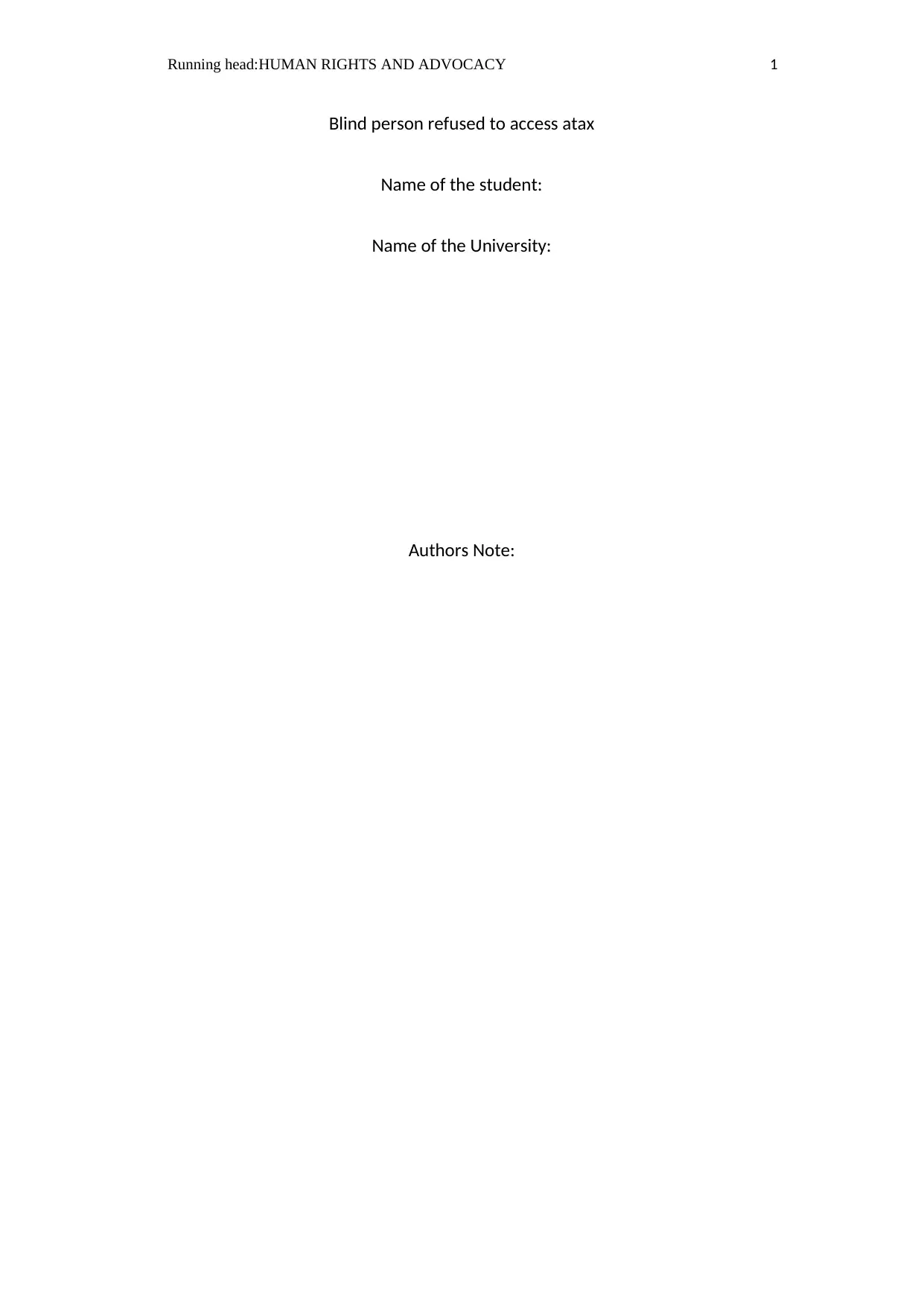
Running head:HUMAN RIGHTS AND ADVOCACY 1
Blind person refused to access atax
Name of the student:
Name of the University:
Authors Note:
Blind person refused to access atax
Name of the student:
Name of the University:
Authors Note:
Paraphrase This Document
Need a fresh take? Get an instant paraphrase of this document with our AI Paraphraser
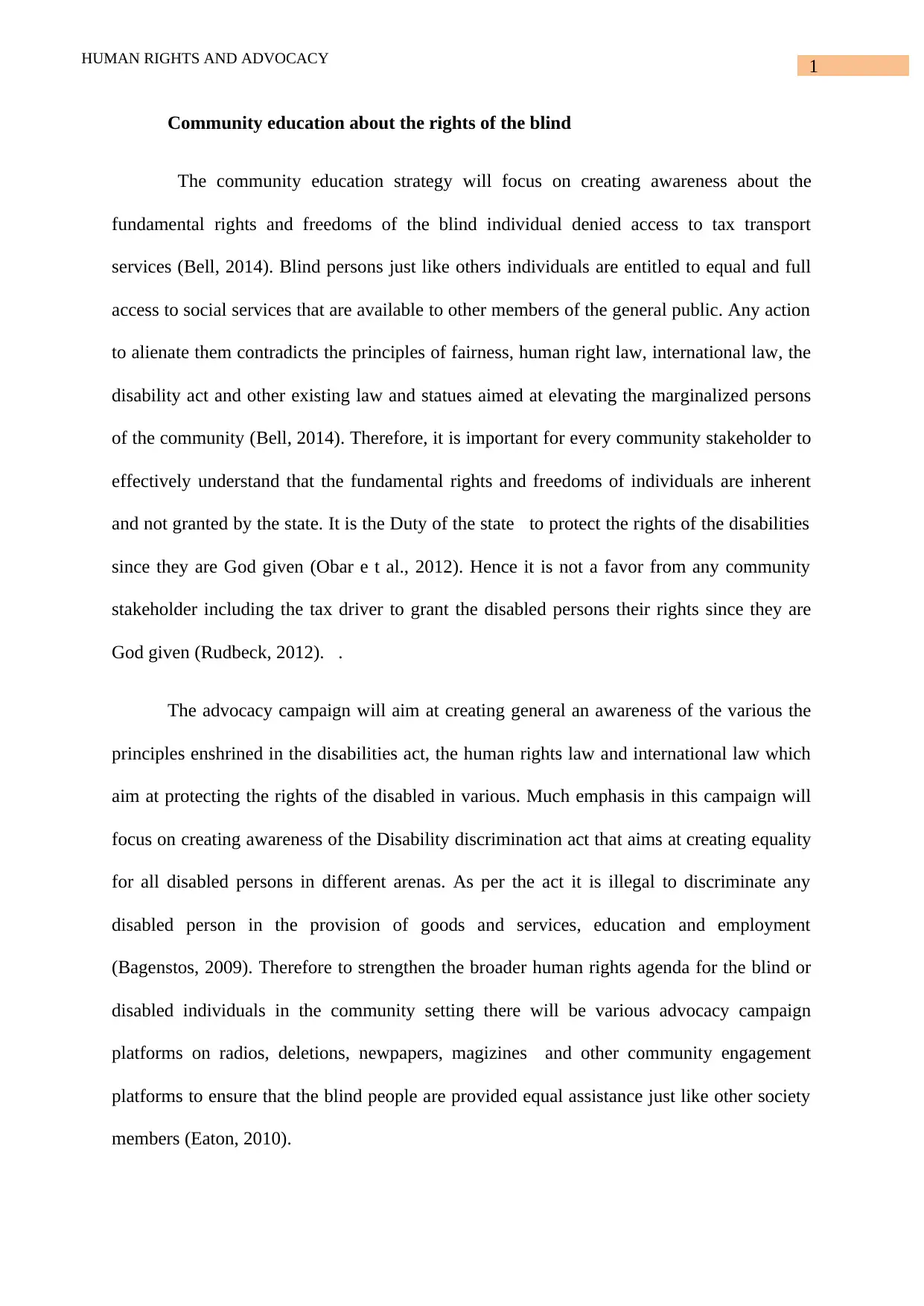
1HUMAN RIGHTS AND ADVOCACY
Community education about the rights of the blind
The community education strategy will focus on creating awareness about the
fundamental rights and freedoms of the blind individual denied access to tax transport
services (Bell, 2014). Blind persons just like others individuals are entitled to equal and full
access to social services that are available to other members of the general public. Any action
to alienate them contradicts the principles of fairness, human right law, international law, the
disability act and other existing law and statues aimed at elevating the marginalized persons
of the community (Bell, 2014). Therefore, it is important for every community stakeholder to
effectively understand that the fundamental rights and freedoms of individuals are inherent
and not granted by the state. It is the Duty of the state to protect the rights of the disabilities
since they are God given (Obar e t al., 2012). Hence it is not a favor from any community
stakeholder including the tax driver to grant the disabled persons their rights since they are
God given (Rudbeck, 2012). .
The advocacy campaign will aim at creating general an awareness of the various the
principles enshrined in the disabilities act, the human rights law and international law which
aim at protecting the rights of the disabled in various. Much emphasis in this campaign will
focus on creating awareness of the Disability discrimination act that aims at creating equality
for all disabled persons in different arenas. As per the act it is illegal to discriminate any
disabled person in the provision of goods and services, education and employment
(Bagenstos, 2009). Therefore to strengthen the broader human rights agenda for the blind or
disabled individuals in the community setting there will be various advocacy campaign
platforms on radios, deletions, newpapers, magizines and other community engagement
platforms to ensure that the blind people are provided equal assistance just like other society
members (Eaton, 2010).
Community education about the rights of the blind
The community education strategy will focus on creating awareness about the
fundamental rights and freedoms of the blind individual denied access to tax transport
services (Bell, 2014). Blind persons just like others individuals are entitled to equal and full
access to social services that are available to other members of the general public. Any action
to alienate them contradicts the principles of fairness, human right law, international law, the
disability act and other existing law and statues aimed at elevating the marginalized persons
of the community (Bell, 2014). Therefore, it is important for every community stakeholder to
effectively understand that the fundamental rights and freedoms of individuals are inherent
and not granted by the state. It is the Duty of the state to protect the rights of the disabilities
since they are God given (Obar e t al., 2012). Hence it is not a favor from any community
stakeholder including the tax driver to grant the disabled persons their rights since they are
God given (Rudbeck, 2012). .
The advocacy campaign will aim at creating general an awareness of the various the
principles enshrined in the disabilities act, the human rights law and international law which
aim at protecting the rights of the disabled in various. Much emphasis in this campaign will
focus on creating awareness of the Disability discrimination act that aims at creating equality
for all disabled persons in different arenas. As per the act it is illegal to discriminate any
disabled person in the provision of goods and services, education and employment
(Bagenstos, 2009). Therefore to strengthen the broader human rights agenda for the blind or
disabled individuals in the community setting there will be various advocacy campaign
platforms on radios, deletions, newpapers, magizines and other community engagement
platforms to ensure that the blind people are provided equal assistance just like other society
members (Eaton, 2010).
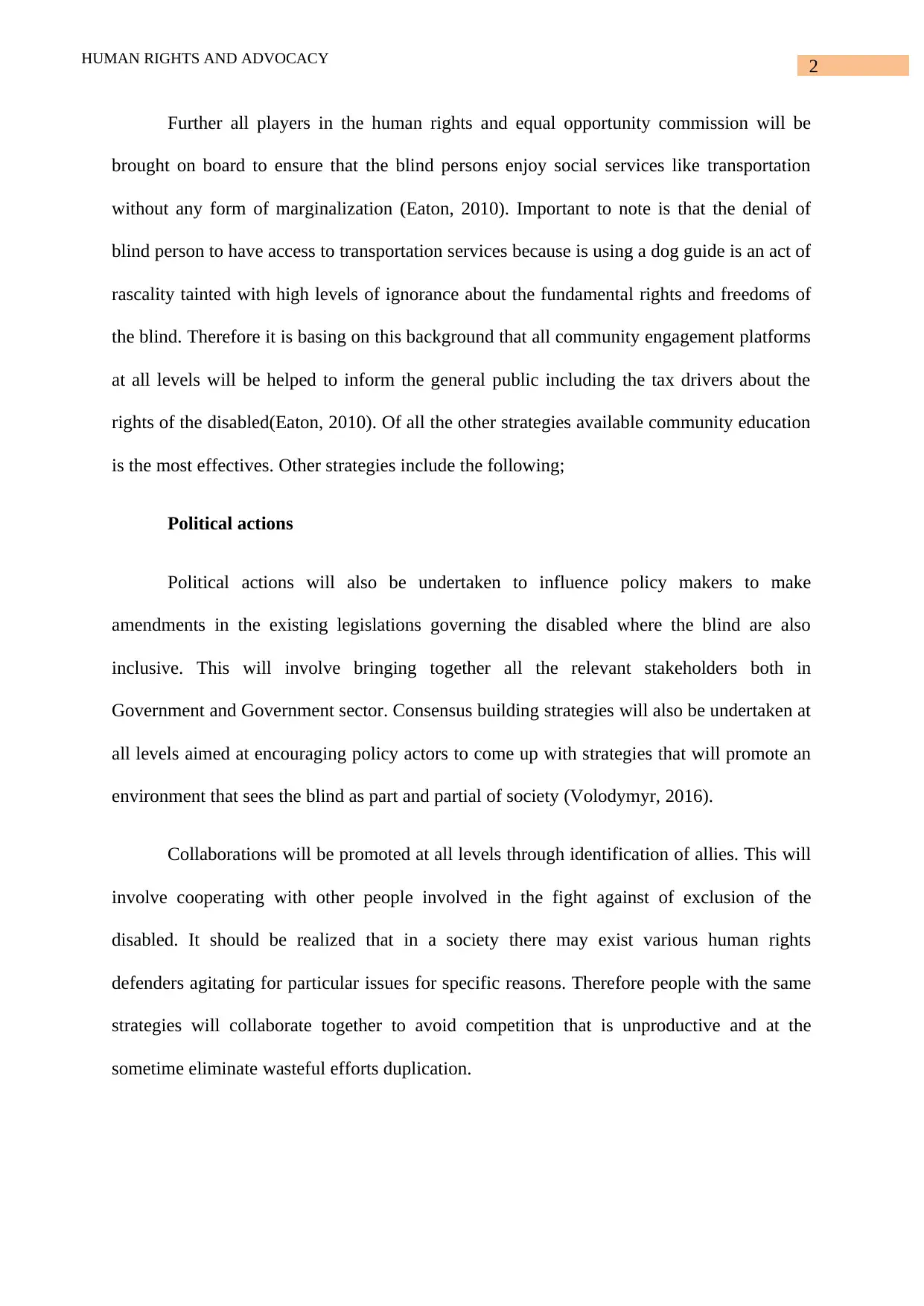
2HUMAN RIGHTS AND ADVOCACY
Further all players in the human rights and equal opportunity commission will be
brought on board to ensure that the blind persons enjoy social services like transportation
without any form of marginalization (Eaton, 2010). Important to note is that the denial of
blind person to have access to transportation services because is using a dog guide is an act of
rascality tainted with high levels of ignorance about the fundamental rights and freedoms of
the blind. Therefore it is basing on this background that all community engagement platforms
at all levels will be helped to inform the general public including the tax drivers about the
rights of the disabled(Eaton, 2010). Of all the other strategies available community education
is the most effectives. Other strategies include the following;
Political actions
Political actions will also be undertaken to influence policy makers to make
amendments in the existing legislations governing the disabled where the blind are also
inclusive. This will involve bringing together all the relevant stakeholders both in
Government and Government sector. Consensus building strategies will also be undertaken at
all levels aimed at encouraging policy actors to come up with strategies that will promote an
environment that sees the blind as part and partial of society (Volodymyr, 2016).
Collaborations will be promoted at all levels through identification of allies. This will
involve cooperating with other people involved in the fight against of exclusion of the
disabled. It should be realized that in a society there may exist various human rights
defenders agitating for particular issues for specific reasons. Therefore people with the same
strategies will collaborate together to avoid competition that is unproductive and at the
sometime eliminate wasteful efforts duplication.
Further all players in the human rights and equal opportunity commission will be
brought on board to ensure that the blind persons enjoy social services like transportation
without any form of marginalization (Eaton, 2010). Important to note is that the denial of
blind person to have access to transportation services because is using a dog guide is an act of
rascality tainted with high levels of ignorance about the fundamental rights and freedoms of
the blind. Therefore it is basing on this background that all community engagement platforms
at all levels will be helped to inform the general public including the tax drivers about the
rights of the disabled(Eaton, 2010). Of all the other strategies available community education
is the most effectives. Other strategies include the following;
Political actions
Political actions will also be undertaken to influence policy makers to make
amendments in the existing legislations governing the disabled where the blind are also
inclusive. This will involve bringing together all the relevant stakeholders both in
Government and Government sector. Consensus building strategies will also be undertaken at
all levels aimed at encouraging policy actors to come up with strategies that will promote an
environment that sees the blind as part and partial of society (Volodymyr, 2016).
Collaborations will be promoted at all levels through identification of allies. This will
involve cooperating with other people involved in the fight against of exclusion of the
disabled. It should be realized that in a society there may exist various human rights
defenders agitating for particular issues for specific reasons. Therefore people with the same
strategies will collaborate together to avoid competition that is unproductive and at the
sometime eliminate wasteful efforts duplication.
⊘ This is a preview!⊘
Do you want full access?
Subscribe today to unlock all pages.

Trusted by 1+ million students worldwide
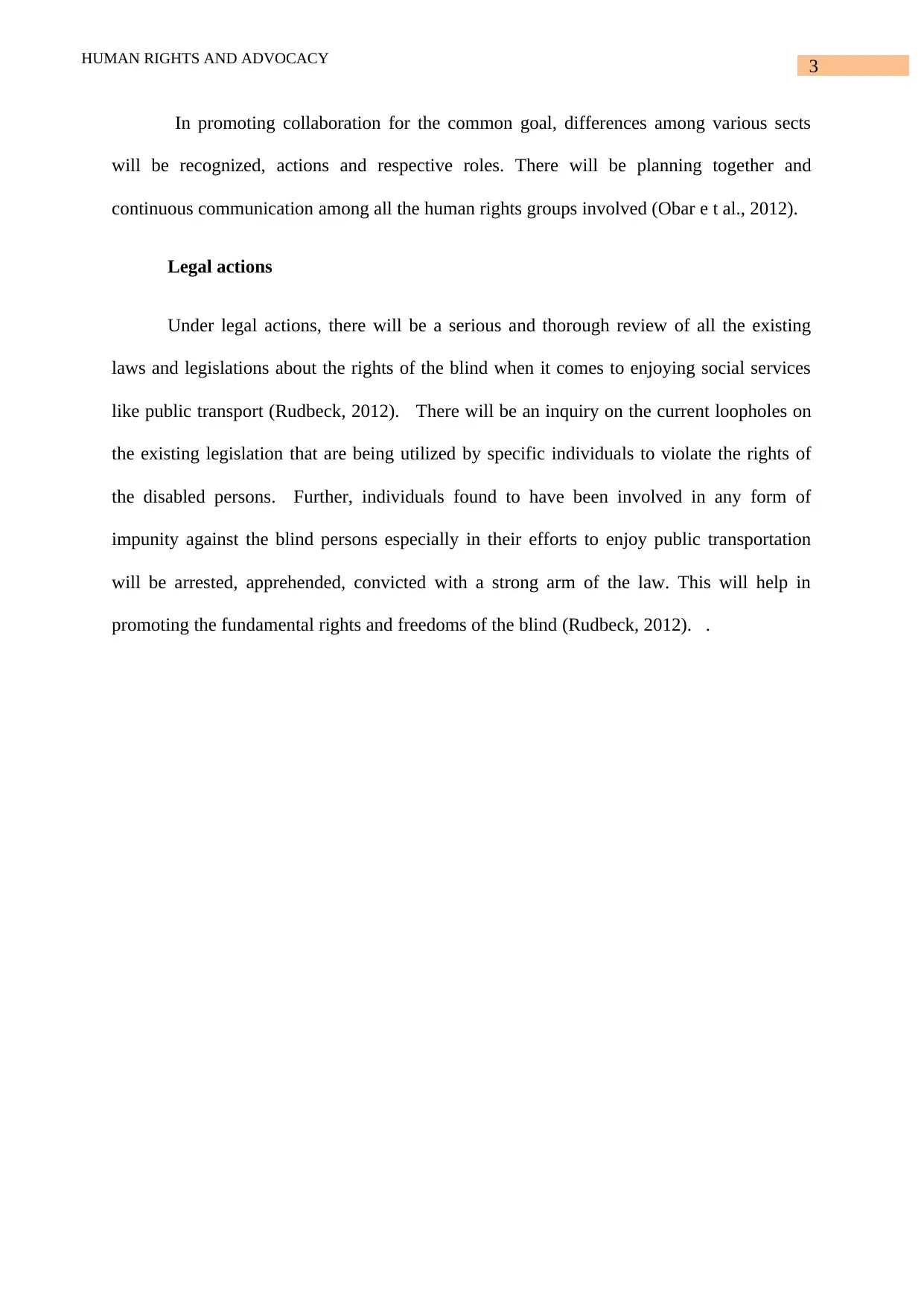
3HUMAN RIGHTS AND ADVOCACY
In promoting collaboration for the common goal, differences among various sects
will be recognized, actions and respective roles. There will be planning together and
continuous communication among all the human rights groups involved (Obar e t al., 2012).
Legal actions
Under legal actions, there will be a serious and thorough review of all the existing
laws and legislations about the rights of the blind when it comes to enjoying social services
like public transport (Rudbeck, 2012). There will be an inquiry on the current loopholes on
the existing legislation that are being utilized by specific individuals to violate the rights of
the disabled persons. Further, individuals found to have been involved in any form of
impunity against the blind persons especially in their efforts to enjoy public transportation
will be arrested, apprehended, convicted with a strong arm of the law. This will help in
promoting the fundamental rights and freedoms of the blind (Rudbeck, 2012). .
In promoting collaboration for the common goal, differences among various sects
will be recognized, actions and respective roles. There will be planning together and
continuous communication among all the human rights groups involved (Obar e t al., 2012).
Legal actions
Under legal actions, there will be a serious and thorough review of all the existing
laws and legislations about the rights of the blind when it comes to enjoying social services
like public transport (Rudbeck, 2012). There will be an inquiry on the current loopholes on
the existing legislation that are being utilized by specific individuals to violate the rights of
the disabled persons. Further, individuals found to have been involved in any form of
impunity against the blind persons especially in their efforts to enjoy public transportation
will be arrested, apprehended, convicted with a strong arm of the law. This will help in
promoting the fundamental rights and freedoms of the blind (Rudbeck, 2012). .
Paraphrase This Document
Need a fresh take? Get an instant paraphrase of this document with our AI Paraphraser
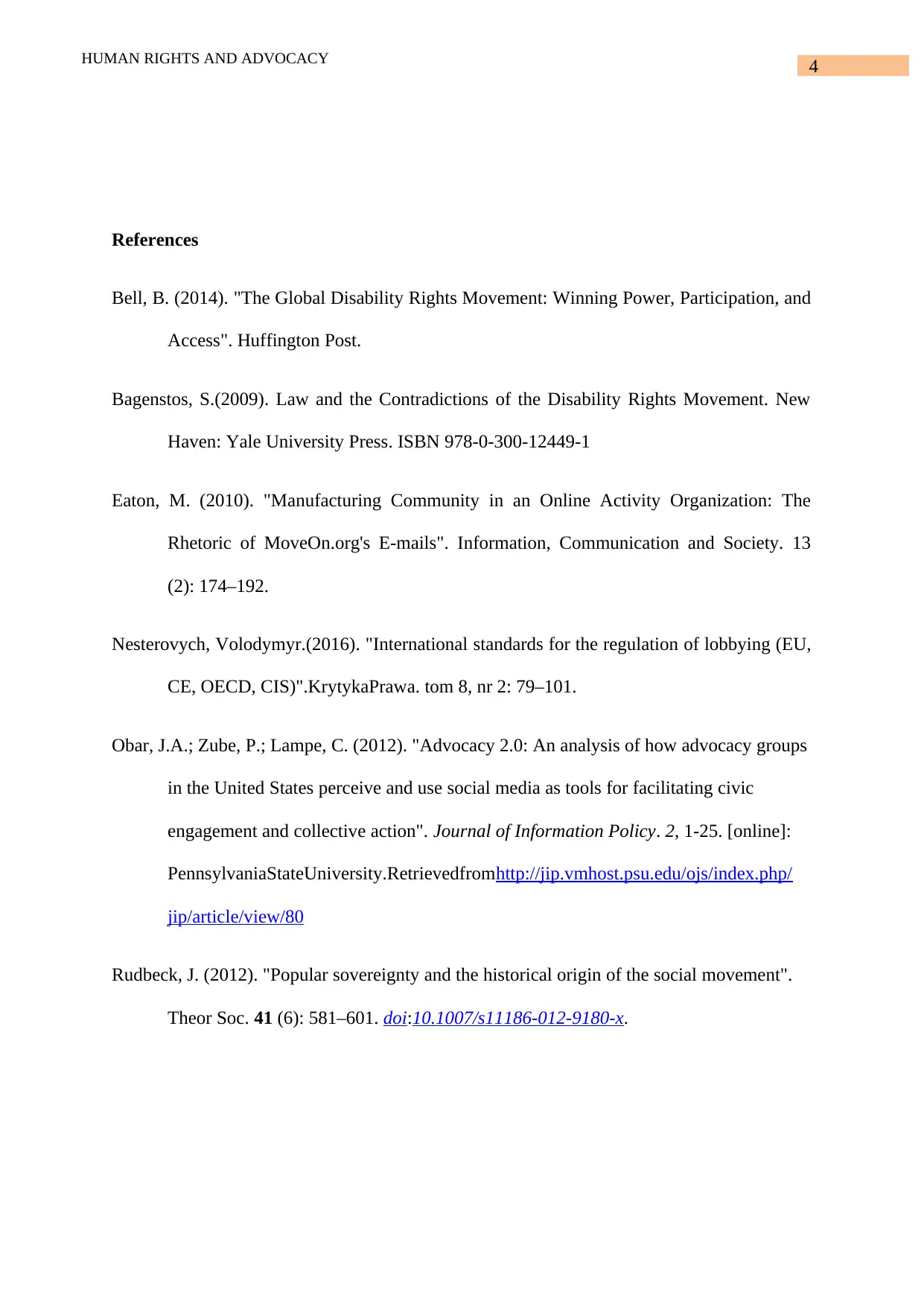
4HUMAN RIGHTS AND ADVOCACY
References
Bell, B. (2014). "The Global Disability Rights Movement: Winning Power, Participation, and
Access". Huffington Post.
Bagenstos, S.(2009). Law and the Contradictions of the Disability Rights Movement. New
Haven: Yale University Press. ISBN 978-0-300-12449-1
Eaton, M. (2010). "Manufacturing Community in an Online Activity Organization: The
Rhetoric of MoveOn.org's E-mails". Information, Communication and Society. 13
(2): 174–192.
Nesterovych, Volodymyr.(2016). "International standards for the regulation of lobbying (EU,
CE, OECD, CIS)".KrytykaPrawa. tom 8, nr 2: 79–101.
Obar, J.A.; Zube, P.; Lampe, C. (2012). "Advocacy 2.0: An analysis of how advocacy groups
in the United States perceive and use social media as tools for facilitating civic
engagement and collective action". Journal of Information Policy. 2, 1-25. [online]:
PennsylvaniaStateUniversity.Retrievedfromhttp://jip.vmhost.psu.edu/ojs/index.php/
jip/article/view/80
Rudbeck, J. (2012). "Popular sovereignty and the historical origin of the social movement".
Theor Soc. 41 (6): 581–601. doi:10.1007/s11186-012-9180-x.
References
Bell, B. (2014). "The Global Disability Rights Movement: Winning Power, Participation, and
Access". Huffington Post.
Bagenstos, S.(2009). Law and the Contradictions of the Disability Rights Movement. New
Haven: Yale University Press. ISBN 978-0-300-12449-1
Eaton, M. (2010). "Manufacturing Community in an Online Activity Organization: The
Rhetoric of MoveOn.org's E-mails". Information, Communication and Society. 13
(2): 174–192.
Nesterovych, Volodymyr.(2016). "International standards for the regulation of lobbying (EU,
CE, OECD, CIS)".KrytykaPrawa. tom 8, nr 2: 79–101.
Obar, J.A.; Zube, P.; Lampe, C. (2012). "Advocacy 2.0: An analysis of how advocacy groups
in the United States perceive and use social media as tools for facilitating civic
engagement and collective action". Journal of Information Policy. 2, 1-25. [online]:
PennsylvaniaStateUniversity.Retrievedfromhttp://jip.vmhost.psu.edu/ojs/index.php/
jip/article/view/80
Rudbeck, J. (2012). "Popular sovereignty and the historical origin of the social movement".
Theor Soc. 41 (6): 581–601. doi:10.1007/s11186-012-9180-x.
1 out of 5
Related Documents
Your All-in-One AI-Powered Toolkit for Academic Success.
+13062052269
info@desklib.com
Available 24*7 on WhatsApp / Email
![[object Object]](/_next/static/media/star-bottom.7253800d.svg)
Unlock your academic potential
Copyright © 2020–2025 A2Z Services. All Rights Reserved. Developed and managed by ZUCOL.





